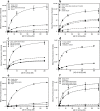Identification of variant HIV envelope proteins with enhanced affinities for precursors to anti-gp41 broadly neutralizing antibodies
- PMID: 31504041
- PMCID: PMC6736307
- DOI: 10.1371/journal.pone.0221550
Identification of variant HIV envelope proteins with enhanced affinities for precursors to anti-gp41 broadly neutralizing antibodies
Abstract
HIV envelope protein (Env) is the sole target of broadly neutralizing antibodies (BNAbs) that are capable of neutralizing diverse strains of HIV. While BNAbs develop spontaneously in a subset of HIV-infected patients, efforts to design an envelope protein-based immunogen to elicit broadly neutralizing antibody responses have so far been unsuccessful. It is hypothesized that a primary barrier to eliciting BNAbs is the fact that HIV envelope proteins bind poorly to the germline-encoded unmutated common ancestor (UCA) precursors to BNAbs. To identify variant forms of Env with increased affinities for the UCA forms of BNAbs 4E10 and 10E8, which target the Membrane Proximal External Region (MPER) of Env, libraries of randomly mutated Env variants were expressed in a yeast surface display system and screened using fluorescence activated cell sorting for cells displaying variants with enhanced abilities to bind the UCA antibodies. Based on analyses of individual clones obtained from the screen and on next-generation sequencing of sorted libraries, distinct but partially overlapping sets of amino acid substitutions conferring enhanced UCA antibody binding were identified. These were particularly enriched in substitutions of arginine for highly conserved tryptophan residues. The UCA-binding variants also generally exhibited enhanced binding to the mature forms of anti-MPER antibodies. Mapping of the identified substitutions into available structures of Env suggest that they may act by destabilizing both the initial pre-fusion conformation and the six-helix bundle involved in fusion of the viral and cell membranes, as well as providing new or expanded epitopes with increased accessibility for the UCA antibodies.
Conflict of interest statement
The authors have read the journal's policy and the authors of this manuscript have the following competing interest: JZ was supported by NIH grant R01GM076485, which was awarded to Dr. David Mathews. Dr. David Mathews is Principal Investigator on R01GM076485 but is not a listed author. This does not alter the authors' adherence to PLOS ONE policies on sharing data and materials.
Figures







Similar articles
-
Envelope deglycosylation enhances antigenicity of HIV-1 gp41 epitopes for both broad neutralizing antibodies and their unmutated ancestor antibodies.PLoS Pathog. 2011 Sep;7(9):e1002200. doi: 10.1371/journal.ppat.1002200. Epub 2011 Sep 1. PLoS Pathog. 2011. PMID: 21909262 Free PMC article.
-
Neutralizing Antibodies Targeting HIV-1 gp41.Viruses. 2020 Oct 23;12(11):1210. doi: 10.3390/v12111210. Viruses. 2020. PMID: 33114242 Free PMC article. Review.
-
Evaluation of a novel multi-immunogen vaccine strategy for targeting 4E10/10E8 neutralizing epitopes on HIV-1 gp41 membrane proximal external region.Virology. 2017 May;505:113-126. doi: 10.1016/j.virol.2017.02.015. Epub 2017 Feb 23. Virology. 2017. PMID: 28237764 Free PMC article.
-
Diverse recombinant HIV-1 Envs fail to activate B cells expressing the germline B cell receptors of the broadly neutralizing anti-HIV-1 antibodies PG9 and 447-52D.J Virol. 2014 Mar;88(5):2645-57. doi: 10.1128/JVI.03228-13. Epub 2013 Dec 18. J Virol. 2014. PMID: 24352455 Free PMC article.
-
Antigp41 membrane proximal external region antibodies and the art of using the membrane for neutralization.Curr Opin HIV AIDS. 2017 May;12(3):250-256. doi: 10.1097/COH.0000000000000364. Curr Opin HIV AIDS. 2017. PMID: 28422789 Review.
References
Publication types
MeSH terms
Substances
Grants and funding
LinkOut - more resources
Full Text Sources
Molecular Biology Databases

